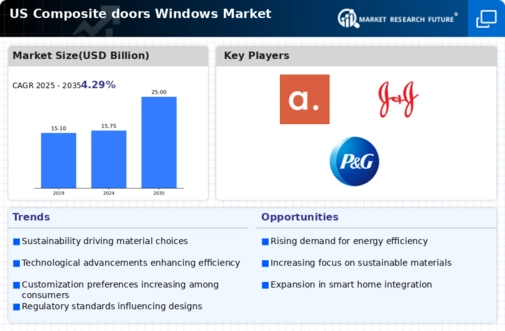Aesthetic Appeal and Design Trends
The composite doors-windows market is significantly influenced by evolving aesthetic preferences among consumers. Homeowners are increasingly prioritizing design elements that enhance the visual appeal of their properties. This trend is reflected in the growing demand for customizable options that allow for unique styles, colors, and finishes. As a result, manufacturers are expanding their product lines to include a variety of designs that cater to diverse tastes. In 2025, it is anticipated that the market for aesthetically pleasing composite doors and windows will grow by approximately 25%, driven by the desire for homes that reflect personal style and modern design trends.
Rising Energy Efficiency Standards
The composite doors-windows market is experiencing a notable shift due to increasing energy efficiency standards mandated by regulatory bodies. These standards aim to reduce energy consumption in residential and commercial buildings, thereby promoting the adoption of energy-efficient products. As a result, manufacturers are compelled to innovate and enhance the thermal performance of composite doors and windows. The market is projected to grow as consumers seek products that not only comply with these regulations but also offer long-term savings on energy bills. In 2025, it is estimated that energy-efficient windows could account for over 40% of the total window market, indicating a strong trend towards energy-conscious purchasing decisions.
Increased Home Renovation Activities
The composite doors-windows market is benefiting from a surge in home renovation activities across the United States. As homeowners invest in upgrading their properties, the demand for high-quality composite doors and windows is on the rise. This trend is fueled by the desire to improve energy efficiency, enhance security, and increase property value. According to recent data, the home renovation market is expected to reach $400 billion by the end of 2025, with a significant portion allocated to window and door replacements. This growth presents a lucrative opportunity for manufacturers in the composite doors-windows market to capture a larger share of the renovation segment.
Growing Awareness of Security Features
The composite doors-windows market is increasingly shaped by consumer awareness regarding security features. As safety concerns rise, homeowners are prioritizing products that offer enhanced security measures. Composite doors and windows are often designed with advanced locking systems and impact-resistant materials, making them a preferred choice for security-conscious consumers. This trend is likely to drive market growth, as manufacturers focus on integrating innovative security features into their offerings. In 2025, it is projected that security-enhanced composite products could represent nearly 30% of the overall market, reflecting a shift towards prioritizing safety in home improvement decisions.
Government Incentives for Sustainable Building
The composite doors-windows market is positively impacted by government incentives aimed at promoting sustainable building practices. Various federal and state programs offer financial incentives for homeowners and builders who choose energy-efficient and environmentally friendly products. These incentives can significantly reduce the upfront costs associated with purchasing composite doors and windows, making them more accessible to a broader audience. As awareness of sustainability grows, it is expected that the market will see an increase in demand for compliant products. By 2025, it is estimated that government incentives could boost the adoption of composite doors and windows by up to 20%, further driving market expansion.














Leave a Comment